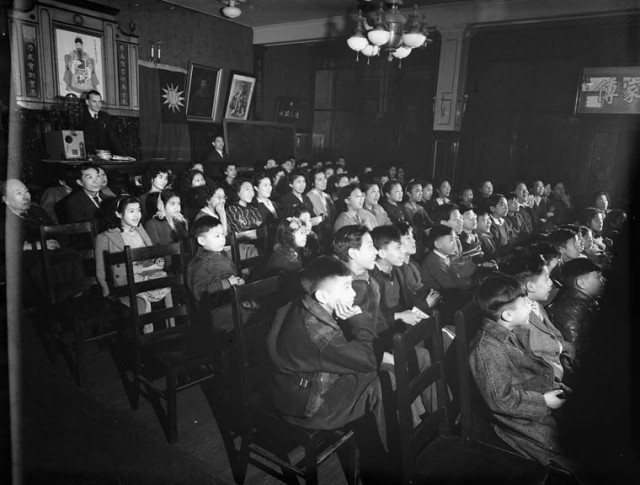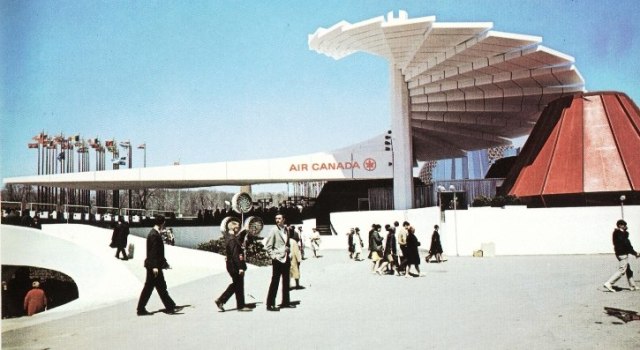
“Chinese-Canadian children watching a National Film Board film.” Click through for original source.
This blog has had many skins since coming into this world. It started as a project for a Canadian Film class. I then took sole custody of its webspace and its content and turned it into a place to have opinions about the NFB. Now it’s fulfilling yet another project-based position for my Photography and Public History seminar.
But although it’s had many skins, I’ve always been at the centre of its guts. And I’ve always had a healthy obsession with the NFB, so to segue its becoming a facet of HIST5702, I think its only fair that I make my intentions clear, known, and up-front. And my intentions are always to steer the conversation back to the illustrious National Film Board of Canada.
In 1939, the Canadian government asked a Scottish filmmaker, John Grierson, to reinvigorate its official public film agency. Grierson was one of the founders of the British documentary movement – he coined the term “documentary” himself.
In an 1940 article Art in Action, Grierson wrote, “art is not a mirror, but a hammer. It is a weapon in our hands to see and to say what is right and good and beautiful and hammer it out as the mould and pattern of men’s actions.” He envisioned a filmic Canadian tradition that would use “moods of resolution” to build a stronger citizenry who would understand “what Canadians need to know and think about if they are going to do their best by Canada and by themselves.” He saw the NFB as a service to the Canadian public, “as an attempt to create a better understanding of Canada’s present and as an aid to the people in mobilizing their imagination and energy in the creation of Canada’s future.”
IRL I am mostly preoccupied with film (obviously), where the immersive environment of the moving picture coupled with sound (and the NFB’s classic didactic voice) doesn’t leave much room for personal negotiation of a message. However, I feel as if the works of the Still Photography Division might leave a little bit more room for people to “interpret Canada to Canadians” (Grierson again) – or, as Canadians, interpret Canada to/for themselves.
Of course the photographs were never presented uncaptioned or unbound, but it’s easy enough to study a photograph without reading the caption (unlike watching a film without the sound, per se). If I were looking at a photograph of some unbridled wilderness or a group of Canadians (maybe we can’t depart from the photo’s context and photographer’s intention there), I could see in it what I may (for the most part). To then read the caption, or think of the photograph in the context of its production, will necessarily change its meaning. But by that point I’ve got my academic goggles on and I can peer through (peel through?) some of the layers of meaning that a single photograph may hold.
I don’t know. Call me a sentimentalist, but I’ve always thought the work of the NFB (at least in the mid-century, my pet era), to be somewhat noble. Maybe not transparent, especially not up for interpretation, but when an institution’s goal is to inspire people to “do their best by Canada” (albeit a white, English, middle-class, urban Canada) the little federalist in me can’t help but feel a swell of pride (however much I know it’s silly and outdated).
I imagine this comes somewhat from a sheen of nostalgia that my keen academic kind just can’t seem to separate from Canada in the fifties. For my undergraduate thesis I looked at the films the NFB produced in the 1950s for and about new immigrants to Canada. And the common refrain that rung throughout was that Canada was a nation with great resources, great population, and great promise. I know, I know, that’s the party line, but how do you ignore it when Tommy Tweed is telling you so over sweeping vistas of Canada’s beautiful countryside and the smiling faces of newly immigrated children and their parents?
Perhaps the answer to that lies in the Still Photography Division. Carol Payne in “Lessons with Leah: re-reading the photographic archive of nation in the National Film Board of Canada’s Still Photography Division” outlines the ways in which federally-appropriated photographs are now being used as a tool of memory-making and being repatriated back to the Inuit communities from whence they were taken. This positioning of the photograph as a physical manifestation of national/colonial power and what can (constructively) be done with it points towards what I can undo to critically (not in a mean way, but in a keen way) unpack the work of the NFB for mid-century Canada.
Which brings me to the photograph above. Found in the online database of Library and Archives Canada, the caption for this photo reads “Chinese-Canadian children watching a National Film Board film.” Seen through my goopy sentamentalist goggles, this is a charming representation of new Canadians learning how to do the best by themselves in their new land, and how to best by their new land as well. A promising pictorial of what awaits Canada and what awaits these young students in the little country that could. At the same time, I have to keep in mind Grierson’s definition of a documentary, “the creative treatment of actuality” – which highlights that there are many layers of meaning, and many layers of power inherent in this photograph.
If I ask the photo some questions (that it attempts to obscure in its official capacity and official caption) I may not get at any immediate answers, but I may get at a deeper story than that which the NFB originally wanted to tell. Where is this viewing taking place? Who are these children? How recently did they become Canadians? What happened to them? Did they take as wrote the message of the film they were watching? What had they learned? Did they apply it? Did they believe it? Did they understand it? Who made the film? Who took this picture? Was it staged, or is this candid? Who are the adults in the back? What was the significance of this viewing, if any? To whom does this photo belong? To whom was it useful then? To whom is it useful now?
I of course, don’t know any of the answers to these questions. But the mere act of asking them in some way complicates my relationship with the NFB (as a fan-girl and as a master’s student). And that’s what I’m here to do, right?



